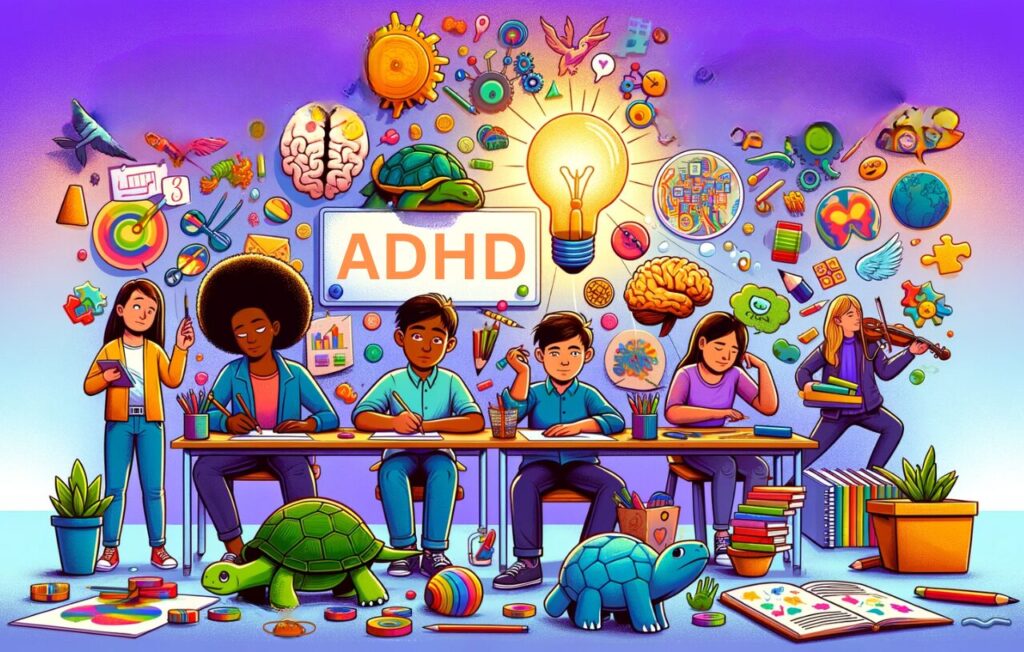Does your child have a hard time focusing on tasks or remaining still more than other children?
Are you an adult and feel disorganized and forgetful and miss important deadlines despite efforts to remember?
If you said yes to the above questions, then you may struggle with Attention-Deficit/Hyperactivity Disorder (ADHD). ADHD is one of the most common neurodevelopmental disorders. Approximately 9% of children and 5% of adults are diagnosed with ADHD. More than half of children diagnosed with ADHD are between the ages of 12 and 17 years old. ADHD is characterized by a persistent pattern of inattention and/or hyperactivity that impacts functioning or development. Despite better recognition and diagnosis of ADHD, there are many common myths about it.
Myth #1: ADHD is a disorder that only children struggle with.
Although ADHD is typically diagnosed in childhood, ADHD symptoms may persist into adulthood. In children, ADHD impacts well-being and day-to-day academic and social functioning. It may interfere with their ability to comprehend and complete chores and schoolwork, relate to their peers, feel capable and competent, and fall and remain asleep. Similar disruptions are also seen in the lives of adults with ADHD. It may interfere with their ability to meet the demands of adulthood, such as by missing work deadlines or forgetting scheduled meetings or by not planning important occasions or missing social events.
Myth #2: People with ADHD are careless and restless.
There are three presentations of ADHD. Individuals with Inattentive ADHD may struggle to concentrate and focus on work, to initiate or finish tasks, not appear to be listening or following instructions, have problems organizing themselves or belongings, or appear forgetful and lose track of things. Individuals with the Hyperactive-Impulsive ADHD may not be able to remain seated in one place for a long period of time, fidget with their hands or feet, appear on edge or constantly in motion, talk too much, or blurt out answers or statements. Individuals may have Combined ADHD where they struggle with all of the above. When it looks like individuals are not giving their best effort or cannot sit still long enough to complete what they need to do, this is likely a result of and the impact of their symptoms.
Myth #3: People with ADHD choose to act like this.
The etiology of ADHD is neurobiological; therefore, individuals are born with it, and do not choose to act inattentive, hyperactive, or impulsive. Individuals with ADHD may struggle in different ways. Some may struggle with different skills such as the ability to initiate and finish tasks, the capacity to plan ahead and meet goals, the ability to follow several directions at once, and the capacity to monitor and control impulses. They may also find it difficult to sit in one place for long periods of time and may do or say inappropriate things, like calling out in class or interrupting a speaker.
Myth 4: The only way to treat ADHD is with medication.
A common treatment for ADHD is medication, such as stimulant medications like amphetamines and methylphenidates and non-stimulant medications like atomoxetine and clonidine. However, there are several therapeutic interventions for ADHD, such as psychotherapy, social skills training, parent skills training, and family therapy, that can also be helpful and effective. These psychotherapeutic interventions may include supporting individuals with identifying problems and symptoms and ways to manage them as well as helping families or teachers develop skills to teach children or adolescents how to regulate their behaviors and emotions.
At Restorative Psychological Services, we can assist with the diagnosis and psychotherapeutic treatment of ADHD.
For more information, please visit these resources:
Centers for Disease Control and Prevention (August, 2022). Data and statistics about ADHD. https://www.cdc.gov/ncbddd/adhd/data.html
Elmaghraby, R., & Garayalde, S. (June, 2022). What is ADHD? American Psychiatric Association. https://www.psychiatry.org/patients-families/adhd/what-is-adhd
Mayo Clinic. (2023). Adult attention-deficit/hyperactivity disorder (ADHD). https://www.mayoclinic.org/diseases-conditions/adult-adhd/symptoms-causes/syc-20350878#:~:text=Adults%20with%20ADHD%20may%20find,Impulsiveness
May Clinic. (2019). Attention-deficit/hyperactivity disorder (ADHD) in children. https://www.mayoclinic.org/diseases-conditions/adhd/diagnosis-treatment/drc-20350895
National Institute of Mental Health (2021). Attention-deficit/hyperactivity disorder in adults: What you need to know. https://www.nimh.nih.gov/health/publications/adhd-what-you-need-to-know
National Institute of Mental Health (2021). Attention-deficit/hyperactivity disorder in children and teens: What you need to know. https://www.nimh.nih.gov/health/publications/attention-deficit-hyperactivity-disorder-in-children-and-teens-what-you-need-to-know#part_9998
Peasgod, T., Bhardwaj, A., Biggs, K., Brazier, J. E., Coghill, D., Cooper, C. L., Daley, D., De Silva, C., Harpin, V., Hodgkins, P., Nadkarni, A., Setyawan, J., & Sonuga-Barke, E. J. S. (2016). The impact of ADHD on the health and well-being of ADHD children and their siblings. European Journal of Child and Adolescent Psychiatry, 25(11), 1217-1231. https://doi.org/10.1007/s00787-016-0841-6
Purper-Ouakil, D., Ramoz, N., Lepagnol-Bestel, A., Gorwood, P., & Simmoneau, M. (2011). Neurobiology of attention-deficit/hyperactivity disorder. Pediatric Research, 69, 69-76. https://doi.org/10.1203/PDR.0b013e3318212b40f
Stevens, M. C., Pearlson, G. D., Calhoun, V. D., & Bessette, K. L. (2018). Functional neuroimaging evidence for distinct neurobiological pathways in attention-deficit/hyperactivity disorder. Biological Psychiatry: Cognitive Neuroscience and Neuroimaging, 3(8), 675-685. https://doi.org/10.1016/j.bpsc.2017.09.005
Wilens, T. E., & Spencer, T. J. (2010). Understanding attention-deficit/hyperactivity disorder from childhood to adulthood. Postgraduate Medicine, 122(5), 97-109. https://doi.org/10.3810/pgm.2010.09.2206
